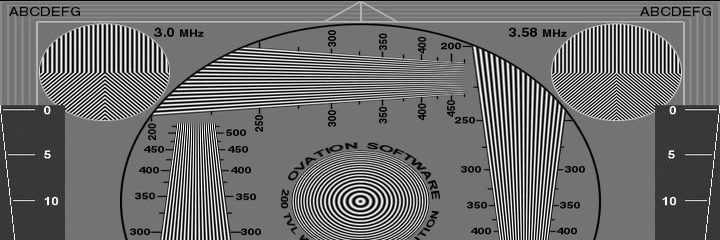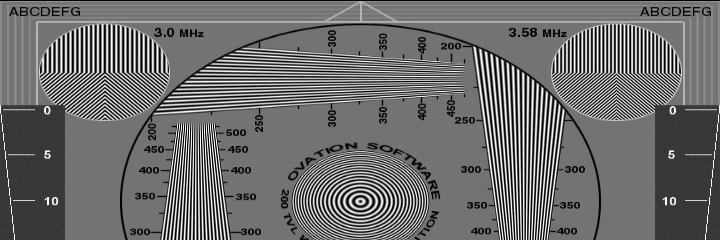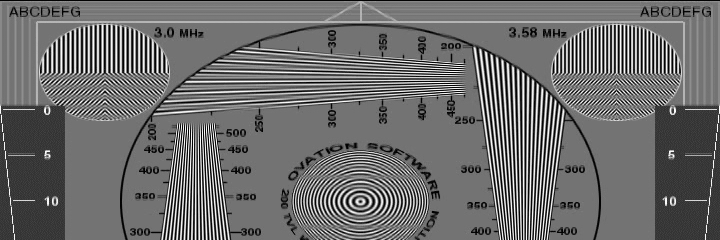Hello all!
I'm trying to convert a PAL movie to NTSC, and have been using a program called DGPulldown, with the guide that is provided on this site, but the problem I am having may be relevant to any form of PAL > NTSC conversion, but not sure.
Basically, when I'm converting to NTSC from PAL, I'm noticing what I guess you'd call "artifacts" in the final product.
For example, in the movie I'm converting, there's a scene with a lamp that is prominent in the scene. In the original PAL file, the edges of the lamp shade are crisp and smooth, but after conversion. I noticed a blocky, "staircase" effect, similar to the effect that you'd get along the edges of objects in a 3D computer game, with the anti-aliasing turned off.
It's kind of hard to explain, but hopefully I'm coming across OK. Basically, I'm noticing that blocky, "staircase" effect on promient vertical or horizontal edges found in the movies I convert.
Is this a side effect of 3:2 pulldown, or is this something I can avoid by using a different PAL > NTSC conversion method?
Any advice or suggestions would be most appreciated. Thanks alot in advance!
+ Reply to Thread
Results 1 to 30 of 30
-
-
Hi,
Could it be a interlace issue?
Kevin
(is the source progressive?)Donatello - The Shredder? Michelangelo - Maybe all that hardware is for making coleslaw? -
How did you resize the frame from 720x576 to 720x480? Is your source interlaced or progressive?
-
OK, this is how I did it.
The original PAL source is progressive. I use TMPGenc Xpress to convert the file to NTSC resolution (720x480) interlaced, while keeping the frame rate (25 fps) intact, as specified in the DG Pulldown guide.
I then use DGPulldown to convert the 720x480 interlaced PAL video to 29.97 fps and then multiplex the original audio with the DG Pulldown video in TMPGenc.
Should I be encoding to 720x480 25 fps PROGRESSIVE instead of interlaced? I was going to try that, but I thought NTSC DVDs WERE interlaced? Now I'm just confused. HAHA.
Thanks in advance for the help! -
OK, here's an update.
I tried converting from progressive PAL to 740x480 PAL Progressive, as opposed to interlaced, and then used DG Pulldown, but the problem is still there.
The quality along the edges of horizontal/vertical lines is still diminished, even though I used progressive. Is this just a side effect of using 3:2 pulldown with DG Pulldown? If so, is there another route I can go that will yield better results? Thanks guys! -
Curmudgeon76, This old message might help you understand interlaced video a bit better:
https://www.videohelp.com/forum/viewtopic.php?p=1334810#1334810
Since your PAL source is progressive be sure that TMPGEnc knows this when you open the file (The program might not get it right on its own.) Also make your NTSC output progressive.
TMPGEnc's resizing algorithm isn't the absolute best but it's not bad. It will not work as well if it thinks your source is interlaced though (no program will).
DGPulldown will then take your 25 FPS hybrid NTSC/PAL file and use a special pulldown pattern (3:2:3:2:2 rather than the usual 3:2) to produce the 59.94 fields-per-second rate required by NTSC video. This doesn't touch the actual compressed MPEG data, it justs adds the information about how to pull down fields. This allows the DVD player to produce 59.94 fields per second from the encoded 25 frame per second video.
How are you judging the quality of the result? Are you burning a DVD and watching on a standard definition TV? I wouldn't trust any software player to display a DGPulldown'd video on the computer correctly. I'm not so sure all high definition televisions will handle it properly either.
It might help if you post a sample frame showing the distortion you are talking about. -
Hey, dude. This is my shining 2 cents: DON"T do PAL to NTSC conversion.
It ain't worth the time and effort and all the problems and quality loss associated with it.
Go and buy yourself a dual-format DVD player. That's all you need to do. -
The only way you will get those jagged edges is if you used too low of a bitrate or resized from a lower resolution or encoded it with the wrong settings.Try 352x480 if the resolution was low to begin with.
I think,therefore i am a hamster. -
Hi-
I agree with junkmalle. First, how does the unpulled down MPV look? Do you see the artifacts in that? If so, then it happened during the encoding.
I've also seen what you describe when playing the finished DGPulldowned DVD, or just the vobs, on the computer, where it was clean on the MPV. That's because the computer players suck, as junkmalle said. They'll get telecined 24fps film correct, but screw up on any other non-standard pattern, as they are pure flag readers and will deinterlace it. That's where your aliasing comes from. If you are burning and then playing on a standard interlaced TV, my guess is that you won't see any artifacts. I don't, when I test mine. If you have a good Progressive Scan DVD player, outputting to an HDTV, you won't see them either. If you have a lousy Progressive Scan player, outputting to an HDTV, then you may see them. That's just a guess though, as I have a good Progressive Scan player, and haven't tested using a lousy one.
And as stated, only use a progressive source encoded progressively. Only progressive output can be pulled down anyway. -
I've never looked closely at TMPGEnc's resizing algorithm so I ran some tests. It appears TMPGEnc uses a simple bilinear resize algorithm. I started with a 720x576 progressive resolution test pattern. I resized it to 720x480 with VirtualDubMod's Lanczos3 filter (what I usually use) and frame served to TMPGEnc. I then resized the source video with TMPGEnc telling it the source was progressive. I resized again telling it the source was interlaced. Here are some crops of the results:
Source:

VirtualDubMod Lacnzos3 resize:

TMPGEnc progressive resize:

TMPGEnc interlaced resize:

The output MPEG files from TMPGEnc were CBR 8000. All frames (I,P,B) looked the same. All still images were saved from VirtualDubMod as 24 bit PNG. I converted them to 8 bit greyscale PNG and cropped to make them smaller for upload.
This type of image is a worst case scenario. Most real world video doesn't look this bad. But this gives you an idea of what types of artifacts to expect. -
That's pretty cool, junkmalle, if discouraging. Thanks for taking the time to run those tests. Although they both look pretty bad, that TMPGEnc interlaced one is obviously significantly worse. I don't know enough about it to offer anything intelligent, but I don't understand why even the TMPGEnc progressive pic looks so bad in comparison to the Lanczos3 resized input. Do you reckon all encoders do similar things?
-
Glad you found the comparison useful! I forgot to mention that resizing with VirtualDubMod's Bilinear filter looked identical to TMPGEnc's progressive resize. So TMPGEnc must use a bilinear filter for resizing.Originally Posted by manono
You might find this description of interlaced resizing helpful in explaining why the interlaced resize looks so much worse than the progressive resize:
https://www.videohelp.com/forum/viewtopic.php?p=1343417#1343417 -
This may be a really stupid suggestion, BUT
What if you re-sized to actually keep the correct AR of the original PAL stream? That would mean resizing the 720x576 PAL to 600x480, centre the picture keeping AR. This would keep the image the correct proportions and do away with the resizing artifacts, would it not?
There would be black bars on the side of the image, but surely this is preferable to any squashing of the image?
Just a thought that came to me last night - feel free to shoot me down! -
You would get even more artifacts from the additional horizontal resizing.Originally Posted by gsh
The image isn't squashed. An NTSC DVD player will display the 720x480 frame as 4:3 picture aspect ratio, just like the PAL player displayed the 720x576 frame as 4:3 picture aspect ratio.Originally Posted by gsh -
The loss of quality when converting from PAL to NTSC leaves me totally confused.
I recently received three DVDs from Australia, in PAL format. Had to go that route, since Space Rangers has not been released on DVD in North America. <grin>
My DVD viewing is driven by a PC - Pentium III 1Ghz, ASUS motherboard, Soundblaster Audigy 2 ZS feeding a JVC 6042 receiver for 5.1 Dolby stereo, ATI Radeon with TV out feeding a 27" Sanyo. Works very, very well. The TV is a North American NTSC model, since I live in Canada.
I put the PAL DVD into my PC. No problem. Plays fine. No problem.
I watch it on my TV. No problem.
To me, this seems like a PAL to NTSC conversion, since the DVD is in PAL format and my TV is in NTSC format.
Why can I do this and see a fantastically sharp, smooth image, yet the often expressed opinion from experienced users is "Don't do PAL to NTSC, the quality sucks"? -
As I mentioned earlier, these types of defects aren't as obvious with "normal" video. Try burning the above source test pattern to a PAL DVD (padding to 576 lines tall of course) and watch it. You'll see the same type of artifacts.Originally Posted by rfielder
Don't watch your commercial DVDs too closely. Once you know what problems to look for you'll start seeing them and they'll piss you off! -
Hi-
Because Lanczos3 is a better method of resizing than Bilinear. It's not the encoder, it's the resize method. TMPGEnc has a built in resize function, which shouldn't be used because it's poor.
Sure, I don't use Bilinear anyway, for that very reason. But it looks as if no matter how you resize it originally, it gets resized again by TMPGEnc using Bilinear, even if only to the same resolution. So, the questions are:
1. Does this Bilinear resizing by TMPGEnc take place no matter what settings you use? That is, is it on by default and can't be changed or turned off? If so, I'm glad I don't use TMPGEnc.
2. Does CCE (and the other encoders) do similar things? If not, I would think those pics alone would put a stop to any further discussion about which is the better encoder.
I realize that junkmalle produced those pics as "artifact enhancers", and that regular encoded video may or may not show those kinds of artifacts, but when trying to make the best possible DVD backups and conversions, knowing that everything gets resized bilinearly is a bit of a showstopper. -
No. If you set Video Arrange to "Center" it doesn't resize. Then you just use AVISynth to feed it, and do your resizing there.Originally Posted by manono
I don't think CCE has resizing, although my trial has expired. The free ones like Quenc and HC don't, they are kept simple and rely on AVISynth for any preprocessing.2. Does CCE (and the other encoders) do similar things? If not, I would think those pics alone would put a stop to any further discussion about which is the better encoder. -
Thanks, MrMoody, I'm feeling better about it now. You know, I almost asked if you could get better results frameserving with AviSynth, since I don't use VDub(Mod) for that anyway. You answered that unasked question. It also looks like you (and junkmalle) made the case for frameserving into TMPGEnc using an AviSynth script when any resizing has to be done, such as for PAL to NTSC or AVI to DVD conversions. Anything that avoids Bilinear resizing has to be a better method.
-
Also, if the output image is the same size as the input image TMPGEnc doesn't resize.Originally Posted by MrMoody
I just repeated the test with AVISynth's Lanczos4Resize filter. It looked almost identical to VirtualDub's Lanzos3 resize. -
Hi-
Good, I'm glad you made that clear. Because earlier you had said:
I resized it to 720x480 with VirtualDubMod's Lanczos3 filter (what I usually use) and frame served to TMPGEnc. I then resized the source video with TMPGEnc telling it the source was progressive.
So you didn't resize because you had to (based on that quote, it was already 720x480 that was input to TMPGEnc, unless I'm misunderstanding), but because you were testing TMPGEnc's resizer.
And the AviSynth LanczosResize is Lanczos3Resize. It's what I use in my scripts. From:
http://www.avisynth.org/Resize
Personally, I find the Lanczos4Resize a bit too sharp when downsizing, like for AVI.Lanczos4Resize is closely related to LanczosResize (correct name: Lanczos3Resize). The latter uses 2*3=6 lobes and the former 2*4=8 lobes to do the resizing. The result is that Lanczos4Resize produces sharper images. Especially usefull when upsizing a clip. -
Manono, In each test I started with a 720x576 PAL MPEG file. In the first test I opened the file with VirtualDubMod, resized to 720x480 with Lanczos3, and frame served to TMPGEnc to encode into MPEG. In the second test I opened the PAL MPEG file directly with TMPGEnc and resized to 720x480 telling it the source was progressive. In the Third test I opened the PAL MPEG file in TMPGEnc, told it the file was interlaced, and resized. The pictures posted were from the three separate MPEG files that TMPGEnc created.
-
I've had a few requests for the full test pattern so here it is...
https://www.videohelp.com/forum/images/guides/p1347262/720x480.zip
This is a 720x480 NTSC frame size. For the above tests I padded the top and bottom to get a full 720x576 PAL frame size (the point of the test was resizing algorithms not aspect ratio).
I found this image in a message in the forums here a year or two ago. -
Wow. Didn't expect this thread to get this big!

Anyway, to get back to my original point, the source I'm encoding from is 25 fps PAL Progressive video, I'm using TMPEGenc Xpress to encode to to NTSC from PAL (keeping the framerate the same, 25fps, but changing the resolution to NTSC, 720x480, for DGpulldown) and encoding to interlaced for NTSC DVD standard.
I'm getting that stair case blocky effect when encoding in TMPGenc Xpress. I found out that it's NOT Dgpulldown (as far as I can tell) that's causing the blockiness. I'd like to post two comparison pics to show you guys what I mean. How can I cap a single frame from a video in Windows? Please let me know. Thanks! -
Another thing I noticed. After encoding the blockiness is worse, but it seems to get EVEN WORSE after using DGPulldown. Maybe it won't look too bad on a TV but it's pissing me off. I'd like to cap a few frames from the original, the converted, and the dgpulldown to show you what I mean. Not sure how to cap a single image though, like I said, anyone that could help, it'd be apprecaited! Thanks!
-
Open your file with VirtualDubMod. Use The slider and arrow keys to get to the frame you want. Then use Video -> Snapshot Source Frame to save that frame.
-
...encoding to interlaced for NTSC DVD standard.
The video must be progressive for any pulldown to work. Since it's progressive, you should also encode as progressive. Go back and have a look at junkmalle's pictures.
Yes, NTSC DVD is an interlaced format, as you mentioned earlier. This means, among other things, that even though the frames might be encoded and stored as progressive 24fps, when they are output by the player, the telecine causes 29.97fps (59.94 fields per second) interlaced, aka 480i, to be sent to the display.
I don't know if your interlaced encoding is the cause of the artifacts (I don't think so), but you'd best do it correctly anyway.
Similar Threads
-
Frame rate conversion for NTSC to PAL conversion?
By Trellis in forum EditingReplies: 33Last Post: 27th Jul 2010, 10:55 -
NTSC video with a film-like/PAL to NTSC conversion type of look that shouldn't
By Bix in forum RestorationReplies: 34Last Post: 8th Feb 2010, 16:17 -
PAL to NTSC, NTSC to PAL framerate conversion?
By Baldrick in forum Video ConversionReplies: 44Last Post: 6th Dec 2009, 00:31 -
Handbrake or WinFF conversion with no loss of video quality?
By sideshowmel in forum Video ConversionReplies: 0Last Post: 13th Jan 2009, 19:15 -
NTSC to PAL, PAL to NTSC framerate conversion?
By Baldrick in forum Video ConversionReplies: 23Last Post: 23rd Apr 2008, 12:19





 Quote
Quote